Program Management Analysis for NextGen Air Traffic Control Project
VerifiedAdded on 2020/04/21
|9
|1791
|33
Project
AI Summary
This project management analysis examines the program management strategies employed for the NextGen air traffic control system within the U.S. National Airspace System. It explores the alignment of program management with project objectives, highlighting how the program aims to reduce traffic delays and manage aircraft effectively. The analysis delves into the dissemination of benefits, emphasizing the positive impact on decision-making and resource management. A key component is the model of program strategy management, including a SWOT analysis that identifies strengths, weaknesses, opportunities, and threats. The project also reviews the use of strategic elements by the FAA, providing a framework for understanding how the program adapts to environmental changes and strives for mission realization. This analysis is valuable for understanding the complexities of program management in a large-scale infrastructure project, offering insights into strategy formulation, implementation, and risk management.
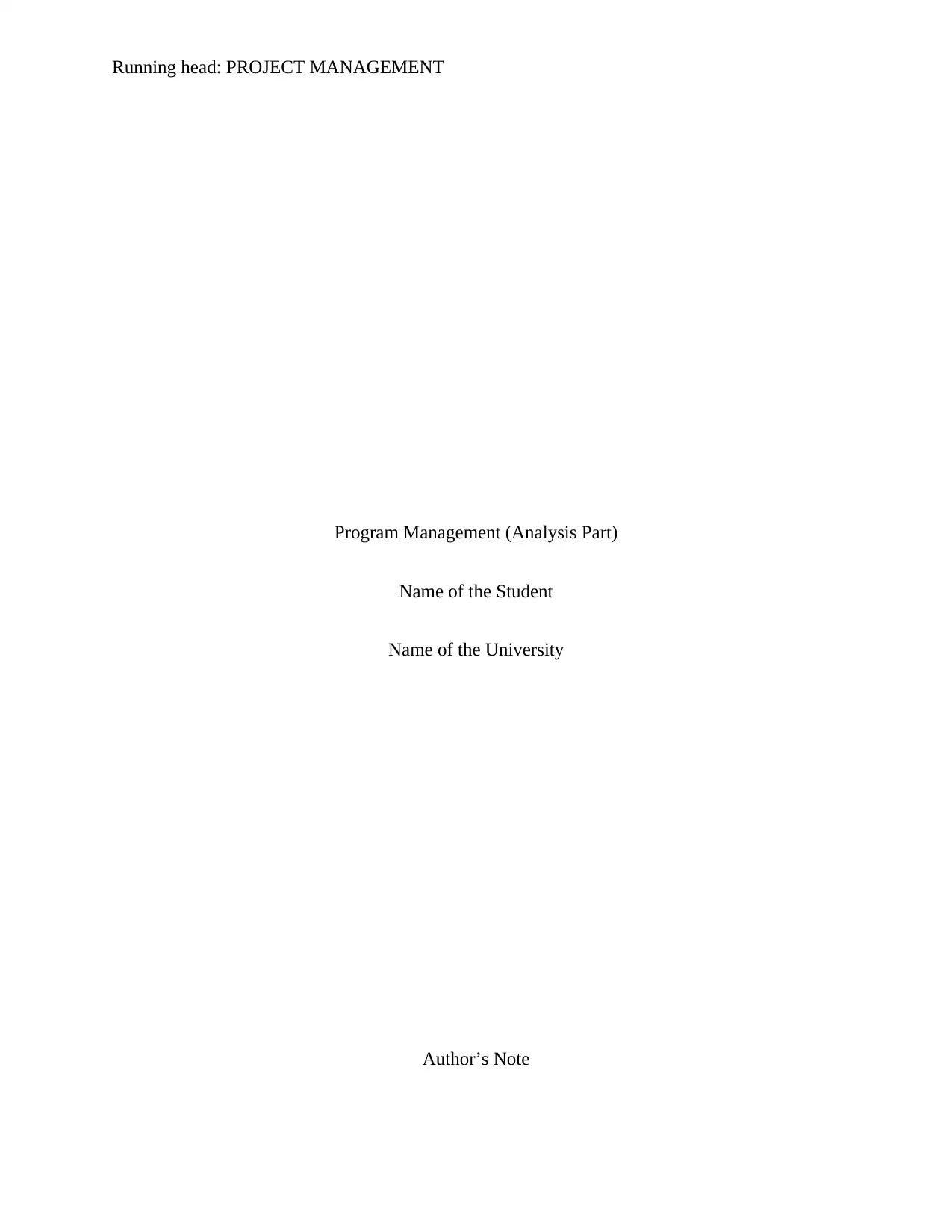
Running head: PROJECT MANAGEMENT
Program Management (Analysis Part)
Name of the Student
Name of the University
Author’s Note
Program Management (Analysis Part)
Name of the Student
Name of the University
Author’s Note
Paraphrase This Document
Need a fresh take? Get an instant paraphrase of this document with our AI Paraphraser
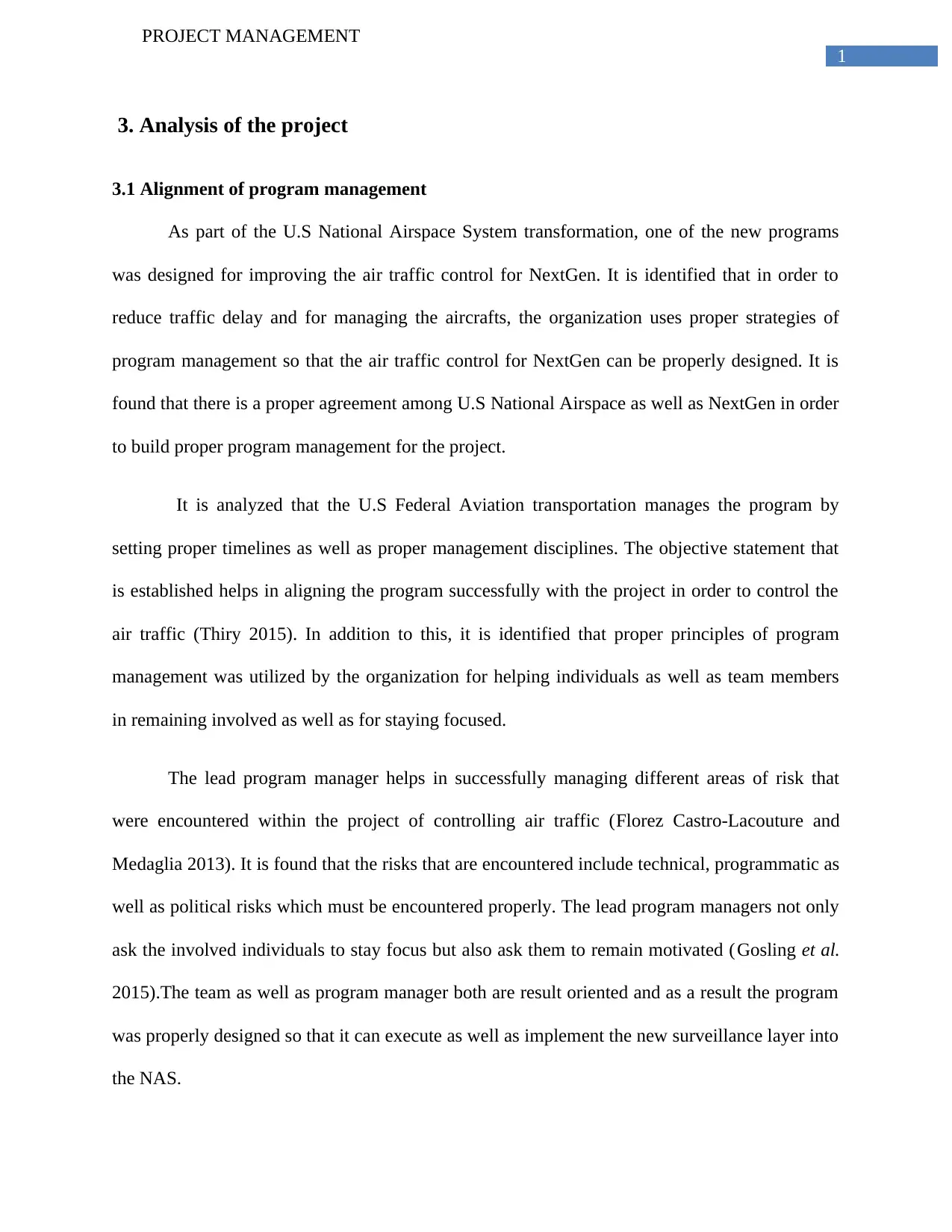
1
PROJECT MANAGEMENT
3. Analysis of the project
3.1 Alignment of program management
As part of the U.S National Airspace System transformation, one of the new programs
was designed for improving the air traffic control for NextGen. It is identified that in order to
reduce traffic delay and for managing the aircrafts, the organization uses proper strategies of
program management so that the air traffic control for NextGen can be properly designed. It is
found that there is a proper agreement among U.S National Airspace as well as NextGen in order
to build proper program management for the project.
It is analyzed that the U.S Federal Aviation transportation manages the program by
setting proper timelines as well as proper management disciplines. The objective statement that
is established helps in aligning the program successfully with the project in order to control the
air traffic (Thiry 2015). In addition to this, it is identified that proper principles of program
management was utilized by the organization for helping individuals as well as team members
in remaining involved as well as for staying focused.
The lead program manager helps in successfully managing different areas of risk that
were encountered within the project of controlling air traffic (Florez Castro-Lacouture and
Medaglia 2013). It is found that the risks that are encountered include technical, programmatic as
well as political risks which must be encountered properly. The lead program managers not only
ask the involved individuals to stay focus but also ask them to remain motivated (Gosling et al.
2015).The team as well as program manager both are result oriented and as a result the program
was properly designed so that it can execute as well as implement the new surveillance layer into
the NAS.
PROJECT MANAGEMENT
3. Analysis of the project
3.1 Alignment of program management
As part of the U.S National Airspace System transformation, one of the new programs
was designed for improving the air traffic control for NextGen. It is identified that in order to
reduce traffic delay and for managing the aircrafts, the organization uses proper strategies of
program management so that the air traffic control for NextGen can be properly designed. It is
found that there is a proper agreement among U.S National Airspace as well as NextGen in order
to build proper program management for the project.
It is analyzed that the U.S Federal Aviation transportation manages the program by
setting proper timelines as well as proper management disciplines. The objective statement that
is established helps in aligning the program successfully with the project in order to control the
air traffic (Thiry 2015). In addition to this, it is identified that proper principles of program
management was utilized by the organization for helping individuals as well as team members
in remaining involved as well as for staying focused.
The lead program manager helps in successfully managing different areas of risk that
were encountered within the project of controlling air traffic (Florez Castro-Lacouture and
Medaglia 2013). It is found that the risks that are encountered include technical, programmatic as
well as political risks which must be encountered properly. The lead program managers not only
ask the involved individuals to stay focus but also ask them to remain motivated (Gosling et al.
2015).The team as well as program manager both are result oriented and as a result the program
was properly designed so that it can execute as well as implement the new surveillance layer into
the NAS.
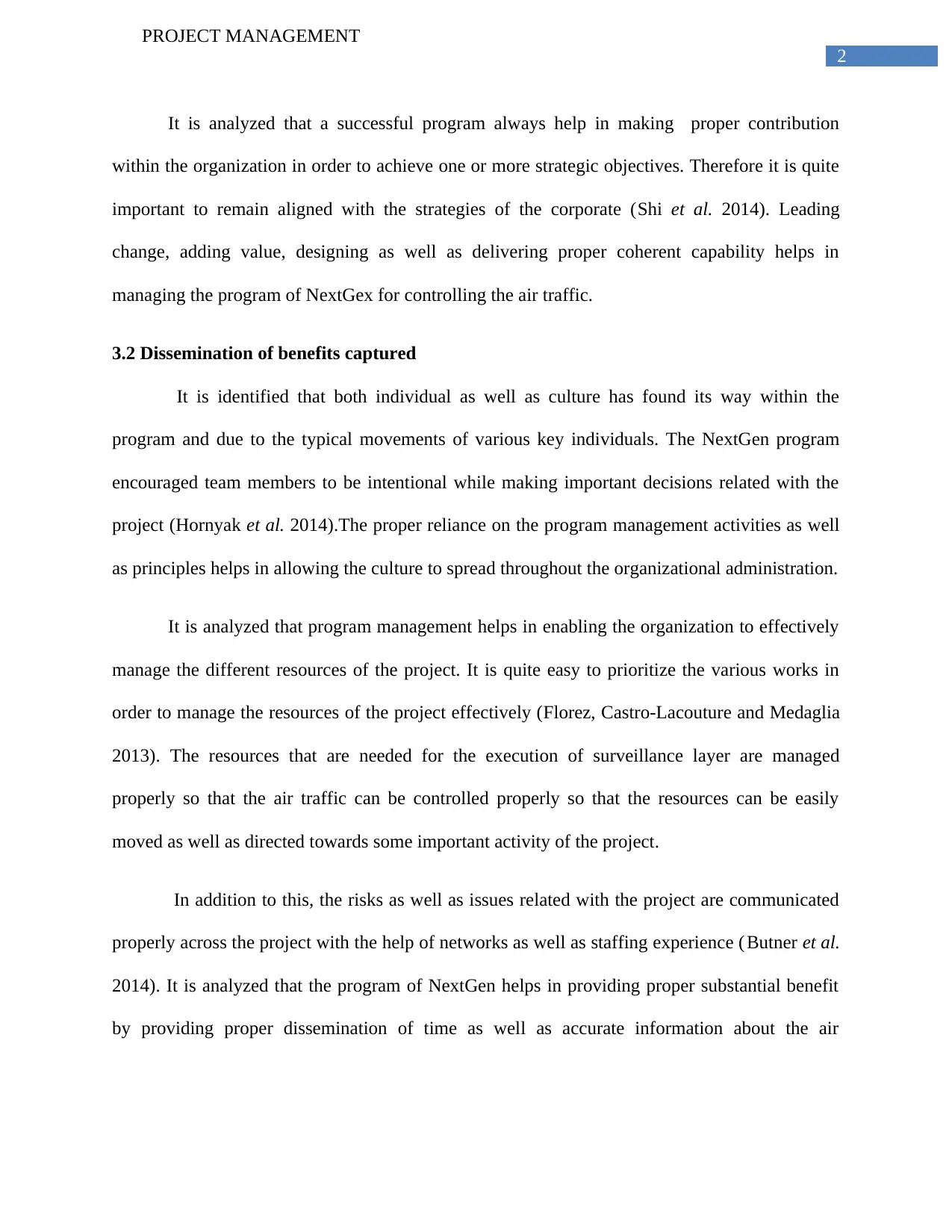
2
PROJECT MANAGEMENT
It is analyzed that a successful program always help in making proper contribution
within the organization in order to achieve one or more strategic objectives. Therefore it is quite
important to remain aligned with the strategies of the corporate (Shi et al. 2014). Leading
change, adding value, designing as well as delivering proper coherent capability helps in
managing the program of NextGex for controlling the air traffic.
3.2 Dissemination of benefits captured
It is identified that both individual as well as culture has found its way within the
program and due to the typical movements of various key individuals. The NextGen program
encouraged team members to be intentional while making important decisions related with the
project (Hornyak et al. 2014).The proper reliance on the program management activities as well
as principles helps in allowing the culture to spread throughout the organizational administration.
It is analyzed that program management helps in enabling the organization to effectively
manage the different resources of the project. It is quite easy to prioritize the various works in
order to manage the resources of the project effectively (Florez, Castro-Lacouture and Medaglia
2013). The resources that are needed for the execution of surveillance layer are managed
properly so that the air traffic can be controlled properly so that the resources can be easily
moved as well as directed towards some important activity of the project.
In addition to this, the risks as well as issues related with the project are communicated
properly across the project with the help of networks as well as staffing experience (Butner et al.
2014). It is analyzed that the program of NextGen helps in providing proper substantial benefit
by providing proper dissemination of time as well as accurate information about the air
PROJECT MANAGEMENT
It is analyzed that a successful program always help in making proper contribution
within the organization in order to achieve one or more strategic objectives. Therefore it is quite
important to remain aligned with the strategies of the corporate (Shi et al. 2014). Leading
change, adding value, designing as well as delivering proper coherent capability helps in
managing the program of NextGex for controlling the air traffic.
3.2 Dissemination of benefits captured
It is identified that both individual as well as culture has found its way within the
program and due to the typical movements of various key individuals. The NextGen program
encouraged team members to be intentional while making important decisions related with the
project (Hornyak et al. 2014).The proper reliance on the program management activities as well
as principles helps in allowing the culture to spread throughout the organizational administration.
It is analyzed that program management helps in enabling the organization to effectively
manage the different resources of the project. It is quite easy to prioritize the various works in
order to manage the resources of the project effectively (Florez, Castro-Lacouture and Medaglia
2013). The resources that are needed for the execution of surveillance layer are managed
properly so that the air traffic can be controlled properly so that the resources can be easily
moved as well as directed towards some important activity of the project.
In addition to this, the risks as well as issues related with the project are communicated
properly across the project with the help of networks as well as staffing experience (Butner et al.
2014). It is analyzed that the program of NextGen helps in providing proper substantial benefit
by providing proper dissemination of time as well as accurate information about the air
⊘ This is a preview!⊘
Do you want full access?
Subscribe today to unlock all pages.

Trusted by 1+ million students worldwide
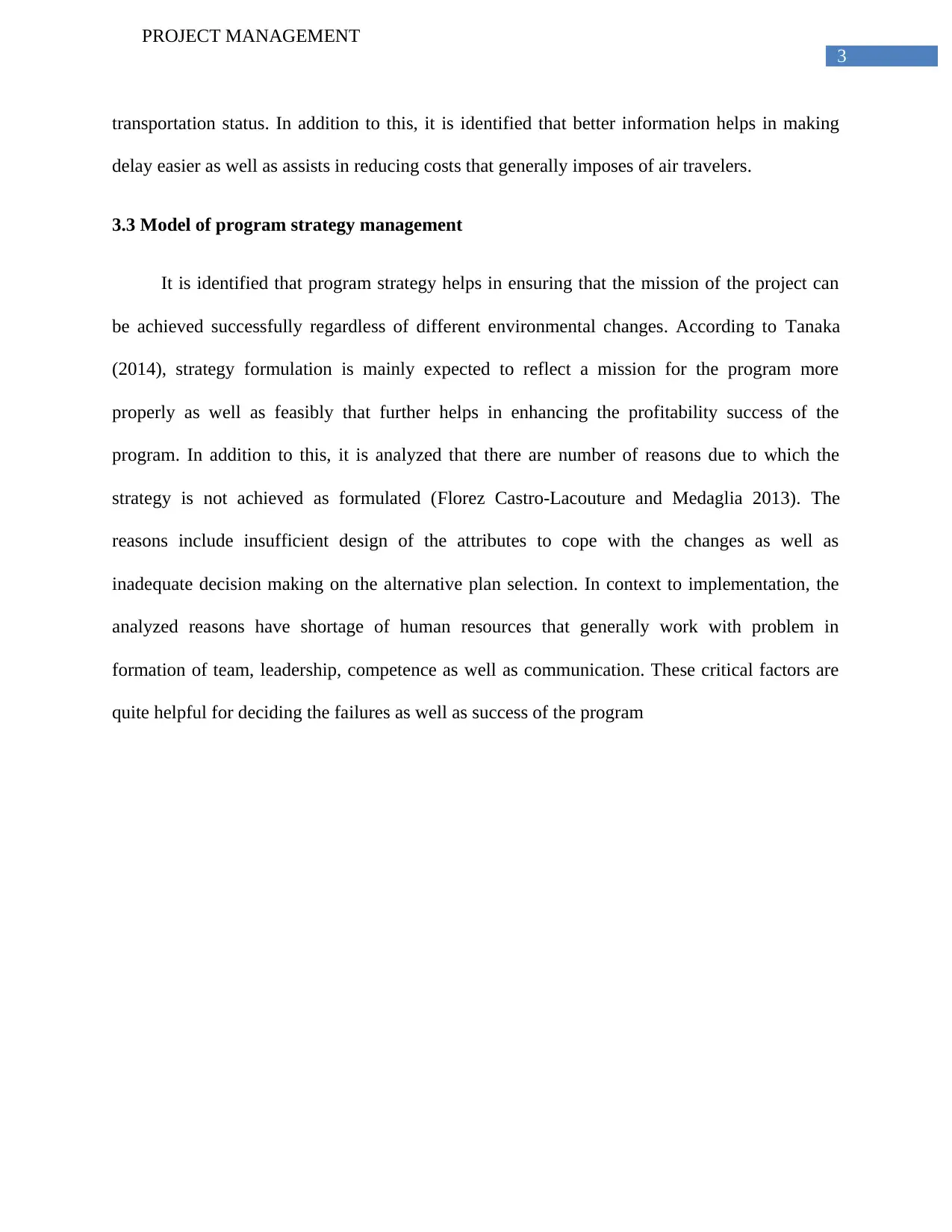
3
PROJECT MANAGEMENT
transportation status. In addition to this, it is identified that better information helps in making
delay easier as well as assists in reducing costs that generally imposes of air travelers.
3.3 Model of program strategy management
It is identified that program strategy helps in ensuring that the mission of the project can
be achieved successfully regardless of different environmental changes. According to Tanaka
(2014), strategy formulation is mainly expected to reflect a mission for the program more
properly as well as feasibly that further helps in enhancing the profitability success of the
program. In addition to this, it is analyzed that there are number of reasons due to which the
strategy is not achieved as formulated (Florez Castro-Lacouture and Medaglia 2013). The
reasons include insufficient design of the attributes to cope with the changes as well as
inadequate decision making on the alternative plan selection. In context to implementation, the
analyzed reasons have shortage of human resources that generally work with problem in
formation of team, leadership, competence as well as communication. These critical factors are
quite helpful for deciding the failures as well as success of the program
PROJECT MANAGEMENT
transportation status. In addition to this, it is identified that better information helps in making
delay easier as well as assists in reducing costs that generally imposes of air travelers.
3.3 Model of program strategy management
It is identified that program strategy helps in ensuring that the mission of the project can
be achieved successfully regardless of different environmental changes. According to Tanaka
(2014), strategy formulation is mainly expected to reflect a mission for the program more
properly as well as feasibly that further helps in enhancing the profitability success of the
program. In addition to this, it is analyzed that there are number of reasons due to which the
strategy is not achieved as formulated (Florez Castro-Lacouture and Medaglia 2013). The
reasons include insufficient design of the attributes to cope with the changes as well as
inadequate decision making on the alternative plan selection. In context to implementation, the
analyzed reasons have shortage of human resources that generally work with problem in
formation of team, leadership, competence as well as communication. These critical factors are
quite helpful for deciding the failures as well as success of the program
Paraphrase This Document
Need a fresh take? Get an instant paraphrase of this document with our AI Paraphraser
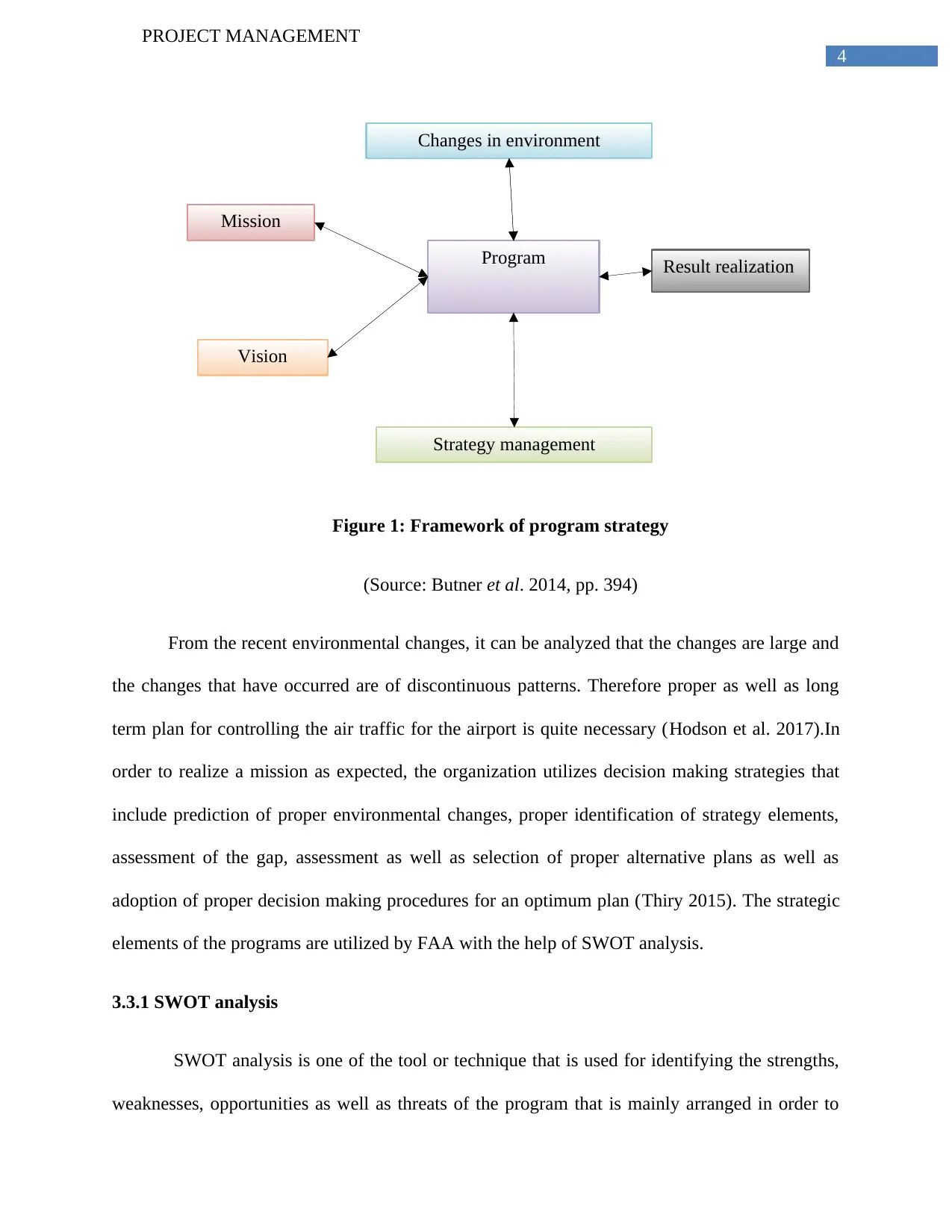
4
PROJECT MANAGEMENT
Changes in environment
Program Result realization
Mission
Vision
Strategy management
Figure 1: Framework of program strategy
(Source: Butner et al. 2014, pp. 394)
From the recent environmental changes, it can be analyzed that the changes are large and
the changes that have occurred are of discontinuous patterns. Therefore proper as well as long
term plan for controlling the air traffic for the airport is quite necessary (Hodson et al. 2017).In
order to realize a mission as expected, the organization utilizes decision making strategies that
include prediction of proper environmental changes, proper identification of strategy elements,
assessment of the gap, assessment as well as selection of proper alternative plans as well as
adoption of proper decision making procedures for an optimum plan (Thiry 2015). The strategic
elements of the programs are utilized by FAA with the help of SWOT analysis.
3.3.1 SWOT analysis
SWOT analysis is one of the tool or technique that is used for identifying the strengths,
weaknesses, opportunities as well as threats of the program that is mainly arranged in order to
PROJECT MANAGEMENT
Changes in environment
Program Result realization
Mission
Vision
Strategy management
Figure 1: Framework of program strategy
(Source: Butner et al. 2014, pp. 394)
From the recent environmental changes, it can be analyzed that the changes are large and
the changes that have occurred are of discontinuous patterns. Therefore proper as well as long
term plan for controlling the air traffic for the airport is quite necessary (Hodson et al. 2017).In
order to realize a mission as expected, the organization utilizes decision making strategies that
include prediction of proper environmental changes, proper identification of strategy elements,
assessment of the gap, assessment as well as selection of proper alternative plans as well as
adoption of proper decision making procedures for an optimum plan (Thiry 2015). The strategic
elements of the programs are utilized by FAA with the help of SWOT analysis.
3.3.1 SWOT analysis
SWOT analysis is one of the tool or technique that is used for identifying the strengths,
weaknesses, opportunities as well as threats of the program that is mainly arranged in order to
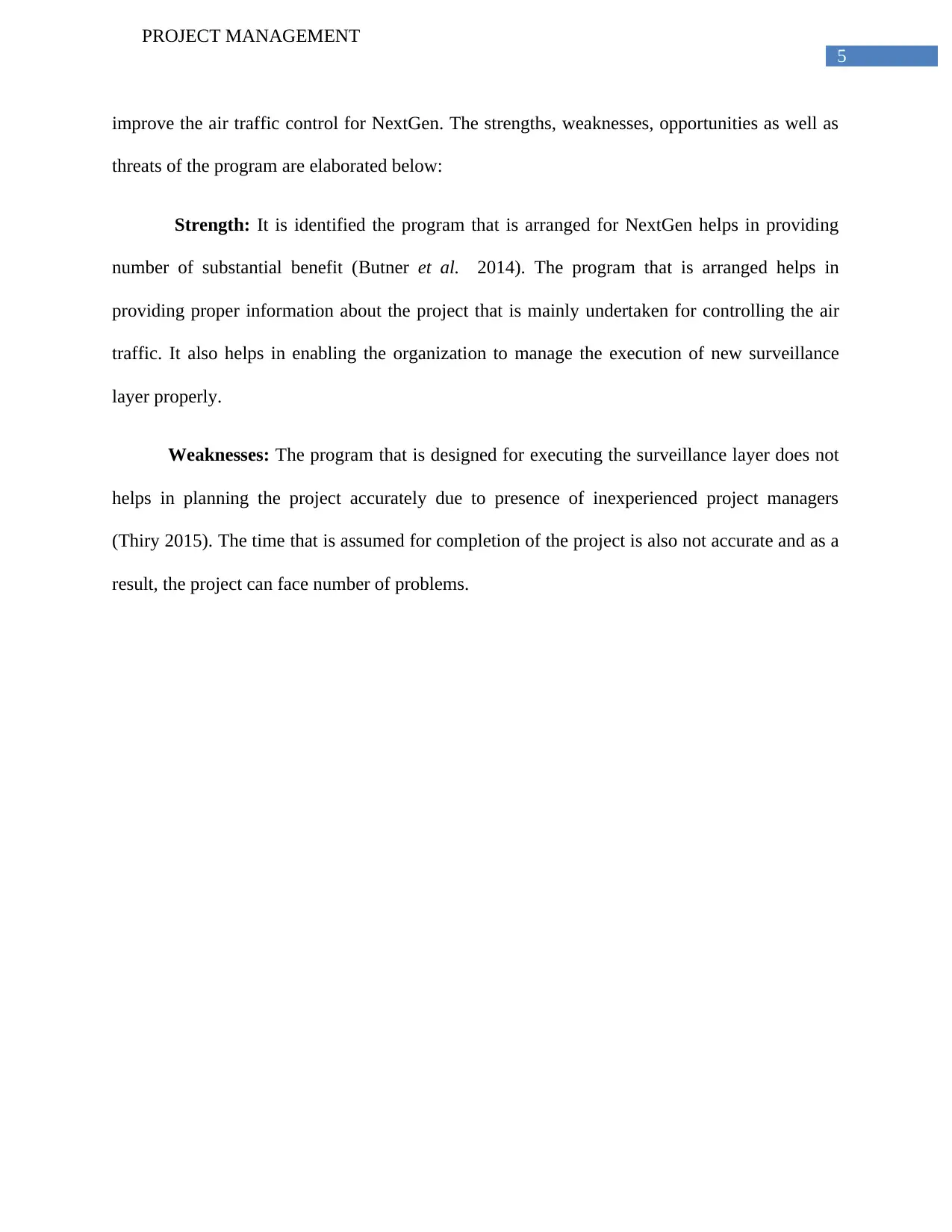
5
PROJECT MANAGEMENT
improve the air traffic control for NextGen. The strengths, weaknesses, opportunities as well as
threats of the program are elaborated below:
Strength: It is identified the program that is arranged for NextGen helps in providing
number of substantial benefit (Butner et al. 2014). The program that is arranged helps in
providing proper information about the project that is mainly undertaken for controlling the air
traffic. It also helps in enabling the organization to manage the execution of new surveillance
layer properly.
Weaknesses: The program that is designed for executing the surveillance layer does not
helps in planning the project accurately due to presence of inexperienced project managers
(Thiry 2015). The time that is assumed for completion of the project is also not accurate and as a
result, the project can face number of problems.
PropersubstantialbenefitManageexecutionoImproperplanningInaccuratetimeestiImproperestimationofbudgetImproperanalysisReductionoftrafficdelayImprovementinairStrengthsWeaknessesThreatsOpportunities
PROJECT MANAGEMENT
improve the air traffic control for NextGen. The strengths, weaknesses, opportunities as well as
threats of the program are elaborated below:
Strength: It is identified the program that is arranged for NextGen helps in providing
number of substantial benefit (Butner et al. 2014). The program that is arranged helps in
providing proper information about the project that is mainly undertaken for controlling the air
traffic. It also helps in enabling the organization to manage the execution of new surveillance
layer properly.
Weaknesses: The program that is designed for executing the surveillance layer does not
helps in planning the project accurately due to presence of inexperienced project managers
(Thiry 2015). The time that is assumed for completion of the project is also not accurate and as a
result, the project can face number of problems.
PropersubstantialbenefitManageexecutionoImproperplanningInaccuratetimeestiImproperestimationofbudgetImproperanalysisReductionoftrafficdelayImprovementinairStrengthsWeaknessesThreatsOpportunities
⊘ This is a preview!⊘
Do you want full access?
Subscribe today to unlock all pages.

Trusted by 1+ million students worldwide
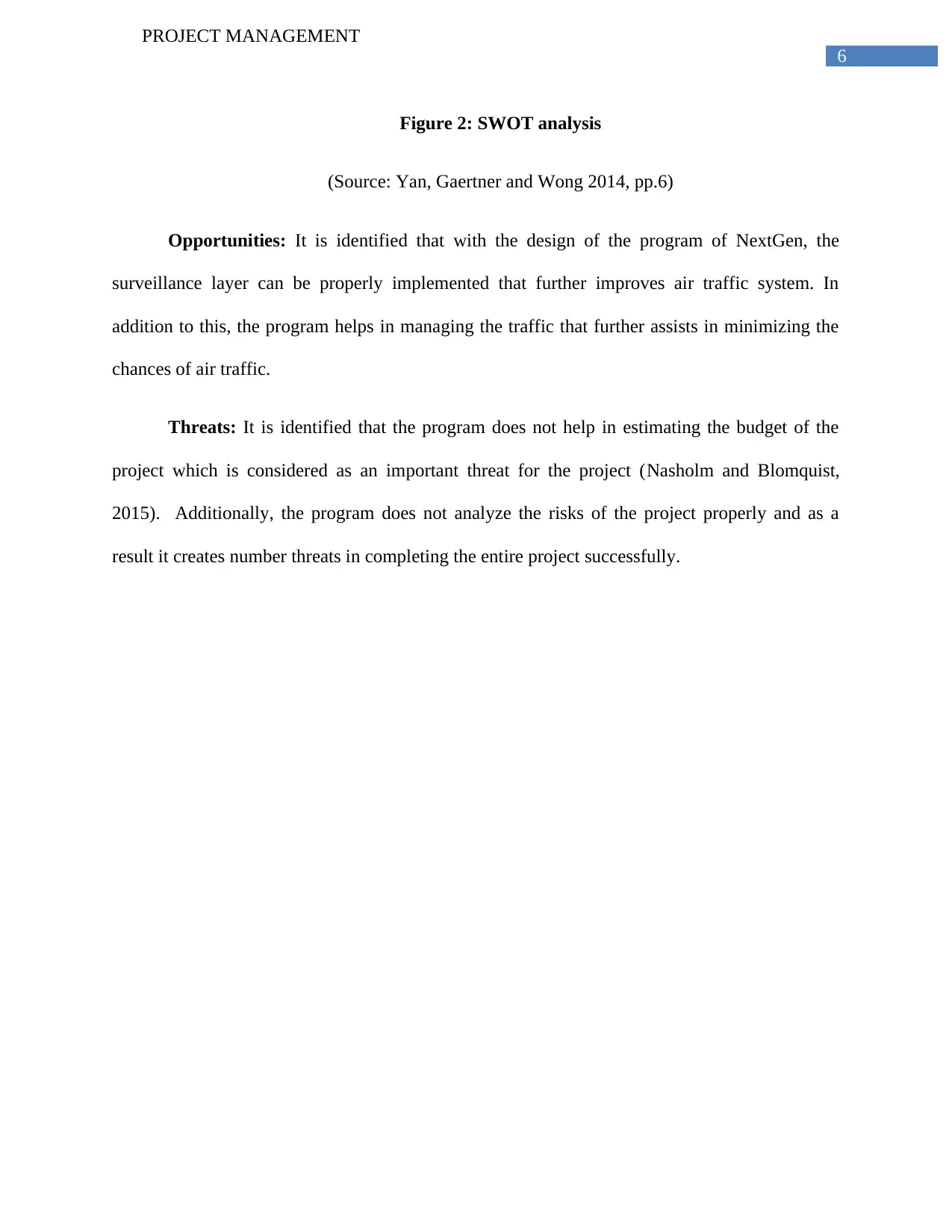
6
PROJECT MANAGEMENT
Figure 2: SWOT analysis
(Source: Yan, Gaertner and Wong 2014, pp.6)
Opportunities: It is identified that with the design of the program of NextGen, the
surveillance layer can be properly implemented that further improves air traffic system. In
addition to this, the program helps in managing the traffic that further assists in minimizing the
chances of air traffic.
Threats: It is identified that the program does not help in estimating the budget of the
project which is considered as an important threat for the project (Nasholm and Blomquist,
2015). Additionally, the program does not analyze the risks of the project properly and as a
result it creates number threats in completing the entire project successfully.
PROJECT MANAGEMENT
Figure 2: SWOT analysis
(Source: Yan, Gaertner and Wong 2014, pp.6)
Opportunities: It is identified that with the design of the program of NextGen, the
surveillance layer can be properly implemented that further improves air traffic system. In
addition to this, the program helps in managing the traffic that further assists in minimizing the
chances of air traffic.
Threats: It is identified that the program does not help in estimating the budget of the
project which is considered as an important threat for the project (Nasholm and Blomquist,
2015). Additionally, the program does not analyze the risks of the project properly and as a
result it creates number threats in completing the entire project successfully.
Paraphrase This Document
Need a fresh take? Get an instant paraphrase of this document with our AI Paraphraser
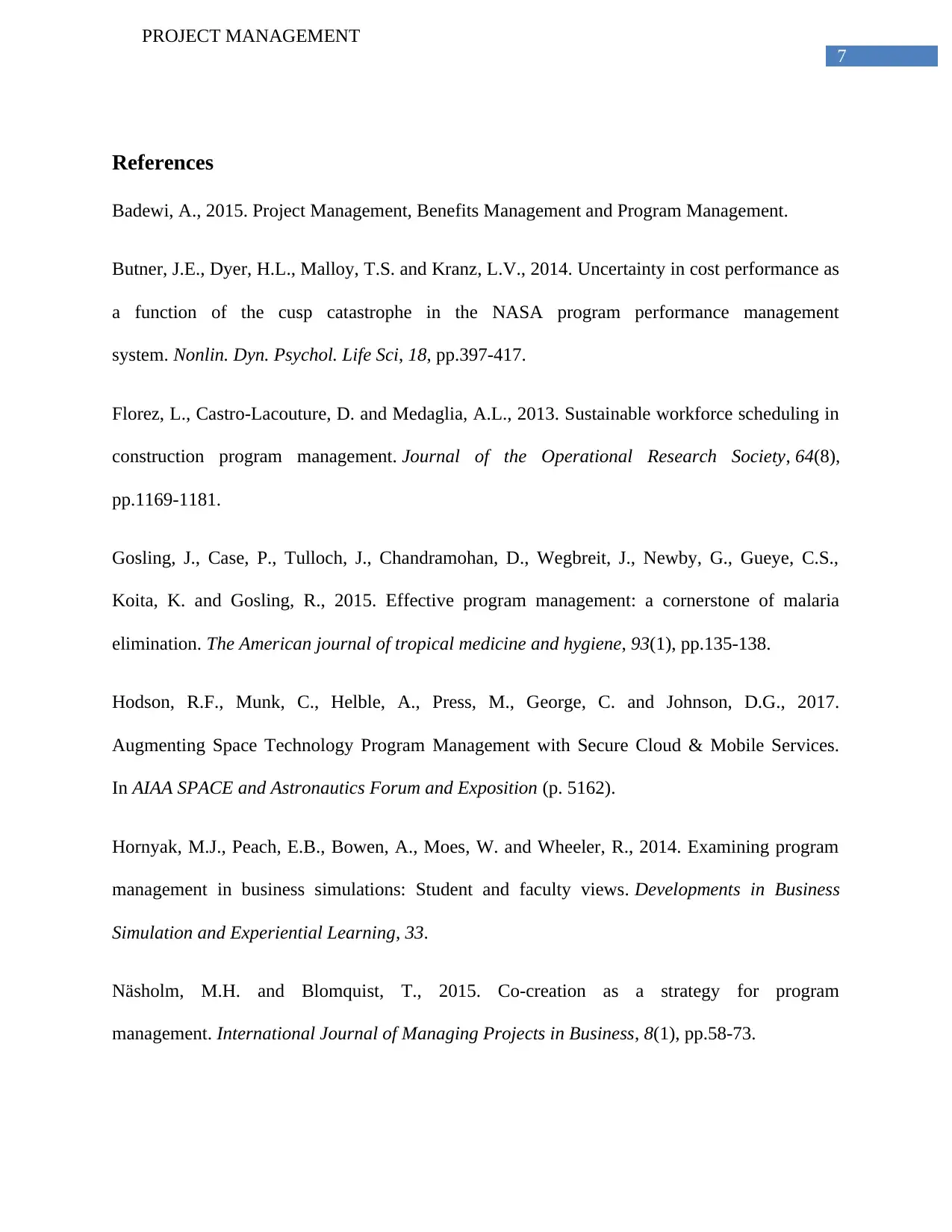
7
PROJECT MANAGEMENT
References
Badewi, A., 2015. Project Management, Benefits Management and Program Management.
Butner, J.E., Dyer, H.L., Malloy, T.S. and Kranz, L.V., 2014. Uncertainty in cost performance as
a function of the cusp catastrophe in the NASA program performance management
system. Nonlin. Dyn. Psychol. Life Sci, 18, pp.397-417.
Florez, L., Castro-Lacouture, D. and Medaglia, A.L., 2013. Sustainable workforce scheduling in
construction program management. Journal of the Operational Research Society, 64(8),
pp.1169-1181.
Gosling, J., Case, P., Tulloch, J., Chandramohan, D., Wegbreit, J., Newby, G., Gueye, C.S.,
Koita, K. and Gosling, R., 2015. Effective program management: a cornerstone of malaria
elimination. The American journal of tropical medicine and hygiene, 93(1), pp.135-138.
Hodson, R.F., Munk, C., Helble, A., Press, M., George, C. and Johnson, D.G., 2017.
Augmenting Space Technology Program Management with Secure Cloud & Mobile Services.
In AIAA SPACE and Astronautics Forum and Exposition (p. 5162).
Hornyak, M.J., Peach, E.B., Bowen, A., Moes, W. and Wheeler, R., 2014. Examining program
management in business simulations: Student and faculty views. Developments in Business
Simulation and Experiential Learning, 33.
Näsholm, M.H. and Blomquist, T., 2015. Co-creation as a strategy for program
management. International Journal of Managing Projects in Business, 8(1), pp.58-73.
PROJECT MANAGEMENT
References
Badewi, A., 2015. Project Management, Benefits Management and Program Management.
Butner, J.E., Dyer, H.L., Malloy, T.S. and Kranz, L.V., 2014. Uncertainty in cost performance as
a function of the cusp catastrophe in the NASA program performance management
system. Nonlin. Dyn. Psychol. Life Sci, 18, pp.397-417.
Florez, L., Castro-Lacouture, D. and Medaglia, A.L., 2013. Sustainable workforce scheduling in
construction program management. Journal of the Operational Research Society, 64(8),
pp.1169-1181.
Gosling, J., Case, P., Tulloch, J., Chandramohan, D., Wegbreit, J., Newby, G., Gueye, C.S.,
Koita, K. and Gosling, R., 2015. Effective program management: a cornerstone of malaria
elimination. The American journal of tropical medicine and hygiene, 93(1), pp.135-138.
Hodson, R.F., Munk, C., Helble, A., Press, M., George, C. and Johnson, D.G., 2017.
Augmenting Space Technology Program Management with Secure Cloud & Mobile Services.
In AIAA SPACE and Astronautics Forum and Exposition (p. 5162).
Hornyak, M.J., Peach, E.B., Bowen, A., Moes, W. and Wheeler, R., 2014. Examining program
management in business simulations: Student and faculty views. Developments in Business
Simulation and Experiential Learning, 33.
Näsholm, M.H. and Blomquist, T., 2015. Co-creation as a strategy for program
management. International Journal of Managing Projects in Business, 8(1), pp.58-73.
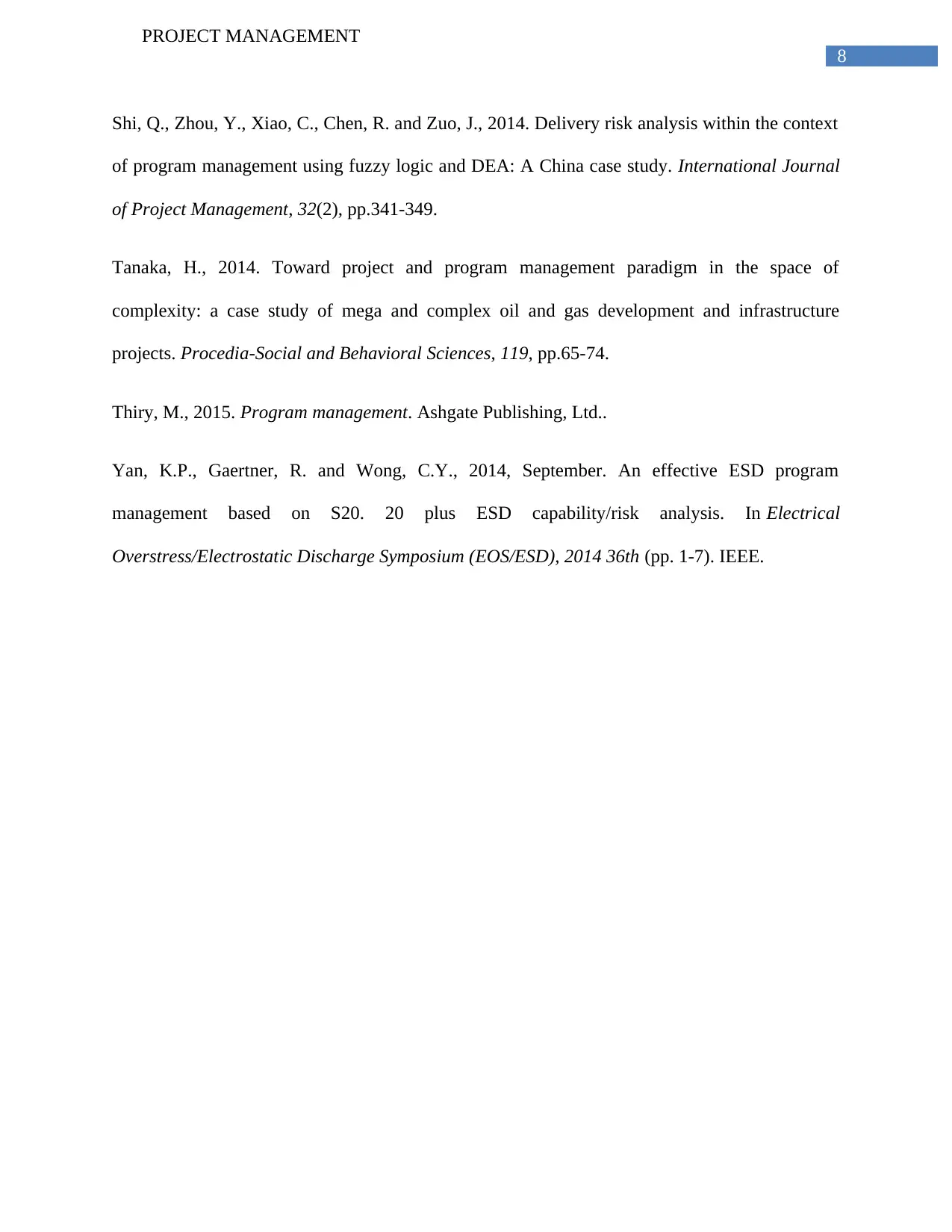
8
PROJECT MANAGEMENT
Shi, Q., Zhou, Y., Xiao, C., Chen, R. and Zuo, J., 2014. Delivery risk analysis within the context
of program management using fuzzy logic and DEA: A China case study. International Journal
of Project Management, 32(2), pp.341-349.
Tanaka, H., 2014. Toward project and program management paradigm in the space of
complexity: a case study of mega and complex oil and gas development and infrastructure
projects. Procedia-Social and Behavioral Sciences, 119, pp.65-74.
Thiry, M., 2015. Program management. Ashgate Publishing, Ltd..
Yan, K.P., Gaertner, R. and Wong, C.Y., 2014, September. An effective ESD program
management based on S20. 20 plus ESD capability/risk analysis. In Electrical
Overstress/Electrostatic Discharge Symposium (EOS/ESD), 2014 36th (pp. 1-7). IEEE.
PROJECT MANAGEMENT
Shi, Q., Zhou, Y., Xiao, C., Chen, R. and Zuo, J., 2014. Delivery risk analysis within the context
of program management using fuzzy logic and DEA: A China case study. International Journal
of Project Management, 32(2), pp.341-349.
Tanaka, H., 2014. Toward project and program management paradigm in the space of
complexity: a case study of mega and complex oil and gas development and infrastructure
projects. Procedia-Social and Behavioral Sciences, 119, pp.65-74.
Thiry, M., 2015. Program management. Ashgate Publishing, Ltd..
Yan, K.P., Gaertner, R. and Wong, C.Y., 2014, September. An effective ESD program
management based on S20. 20 plus ESD capability/risk analysis. In Electrical
Overstress/Electrostatic Discharge Symposium (EOS/ESD), 2014 36th (pp. 1-7). IEEE.
⊘ This is a preview!⊘
Do you want full access?
Subscribe today to unlock all pages.

Trusted by 1+ million students worldwide
1 out of 9
Your All-in-One AI-Powered Toolkit for Academic Success.
+13062052269
info@desklib.com
Available 24*7 on WhatsApp / Email
![[object Object]](/_next/static/media/star-bottom.7253800d.svg)
Unlock your academic potential
Copyright © 2020–2025 A2Z Services. All Rights Reserved. Developed and managed by ZUCOL.


